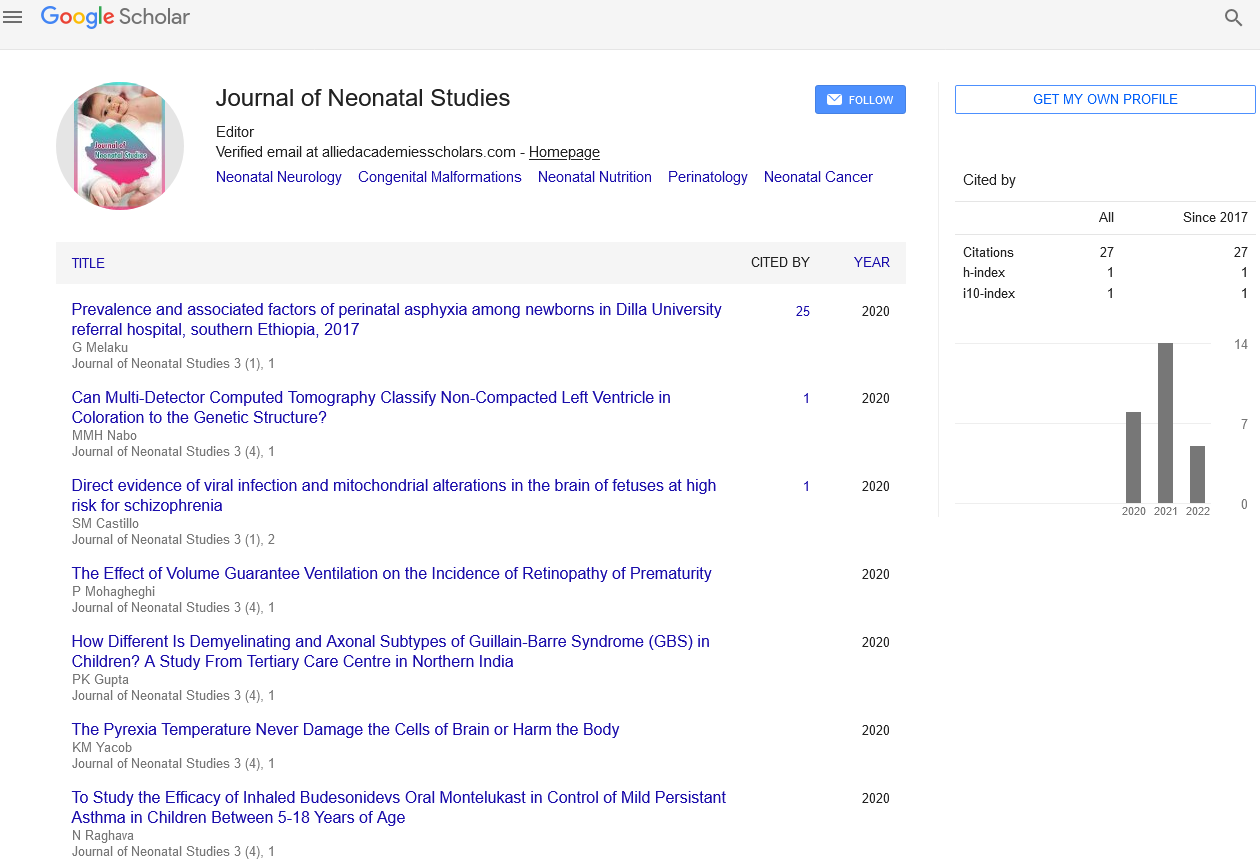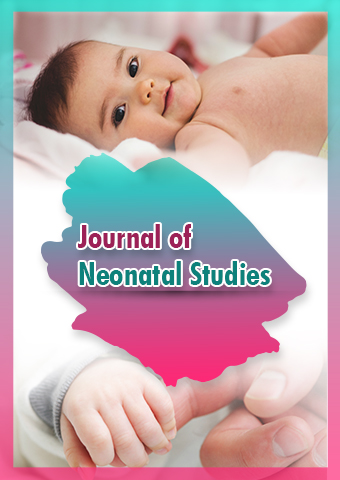Review Article - Journal of Neonatal Studies (2023) Volume 6, Issue 4
Neonatal Rheumatology: Unravelling the Complexities of Early-Onset Autoimmune Disorders
Maktum Al Hakim*
Department of Stem Cell and Research, Saudi Arabia
Department of Stem Cell and Research, Saudi Arabia
E-mail: hakimsaudi@hotmail.com
Received: 01-Aug-2023, Manuscript No. jns-23-109488; Editor assigned: 2-Aug-2023, PreQC No. jns-23- 109488(PQ); Reviewed: 15-Aug-2023, QC No. jns-23-109488; Revised: 22-Aug-2023, Manuscript No. jns-23- 109488(R); Published: 29-Aug-2023; DOI: 10.37532/jns.2023.6(4).108-111
Abstract
Neonatal rheumatology is a specialized field of medicine that focuses on the diagnosis and management of rheumatic diseases in newborns and infants. Rheumatic conditions affecting neonates present unique challenges due to the early onset of symptoms and the complexity of the immune system in this age group. This abstract provides an overview of neonatal rheumatology, discussing the prevalence, clinical manifestations, diagnostic approaches, and treatment modalities for various rheumatic disorders in neonates. It emphasizes the importance of early recognition and intervention to improve outcomes and long-term prognosis for these vulnerable patients. As the understanding of neonatal rheumatology continues to evolve, further research is warranted to refine diagnostic criteria and explore novel therapeutic options tailored to this delicate population. Neonatal rheumatology is a specialized field of medicine that focuses on the diagnosis, treatment, and management of rheumatic and inflammatory disorders in newborns and young infants. These conditions, although rare, can have significant and potentially life-threatening consequences if not promptly identified and addressed. Neonatal rheumatologists play a crucial role in providing early intervention and personalized care to these vulnerable patients. The abstract highlights the importance of early recognition and management of neonatal rheumatological conditions, which include various autoimmune and auto inflammatory diseases. It underscores the significance of collaboration between multidisciplinary healthcare teams to optimize the outcomes for affected infants. The abstract also emphasizes ongoing research efforts to understand the pathogenesis of these conditions, develop novel therapeutic approaches, and improve long-term prognosis for these patients.
Neonatal rheumatology • Rheumatic diseases • Newborn • Infant • Immune system • Clinical manifestations • Diagnosis treatment • Early intervention • Prognosis • Collaboration
Introduction
Neonatal rheumatology is a relatively young and rapidly evolving subspecialty within the field of pediatric rheumatology. It focuses on the diagnosis and management of autoimmune and inflammatory disorders that affect infants and neonates, typically within the first few months of life. While rheumatologic conditions are often associated with adulthood, it is essential to recognize that they can also manifest in early infancy, leading to unique challenges in diagnosis and treatment. This article aims to shed light on neonatal rheumatology, exploring the various conditions, diagnostic approaches, and therapeutic strategies utilized in this specialized field [1].
Neonatal rheumatology is a specialized field of pediatric medicine dedicated to the study and management of rheumatic diseases that affect infants within the first few months of life. Rheumatic diseases encompass a diverse group of autoimmune and inflammatory conditions that can result in joint pain, swelling, and systemic manifestations. While these conditions are relatively rare in neonates, they present unique challenges due to the complexities of diagnosis, the potential for life-threatening complications, and the need for tailored therapeutic approaches suitable for the delicate physiology of newborns [2].
This burgeoning area of research has gained momentum in recent years as advancements in medical technology and diagnostic techniques have improved our understanding of neonatal rheumatology. The neonatal immune system is distinct from that of older children and adults, and its intricate interplay with genetic factors, environmental influences, and maternal antibodies adds layers of complexity to disease development and progression in this age group. Aim to provide an overview of the current state of neonatal rheumatology, highlighting the unique challenges and opportunities that exist in diagnosing, managing, and understanding these conditions in the earliest stages of life.
By shedding light on the latest research findings and clinical practices, we hope to foster interest and collaboration among medical professionals, researchers, and stakeholders to further enhance the care and prospects of neonates affected by rheumatic diseases. As the field continues to evolve, it holds the promise of unlocking critical insights into the broader understanding of autoimmune disorders and the developmental immunology of infancy, potentially revolutionizing how we approach pediatric rheumatology as a whole [3].
Discussion
Prevalence and incidence
Neonatal rheumatology conditions are considered rare, affecting approximately 1 in 8,000 to 1 in 10,000 live births. However, the incidence may be underestimated due to challenges in diagnosing such disorders in the neonatal period, especially when symptoms are subtle or nonspecific. The true prevalence may vary across different geographic regions and ethnic groups, and ongoing research is continually refining our understanding of these diseases.
Common neonatal rheumatologic conditions
Neonatal-Onset Multisystem Inflammatory Disease (NOMID) or Chronic Infantile Neurological Cutaneous and Articular (CINCA) Syndrome: NOMID/CINCA is a rare autosomal dominant auto inflammatory disorder characterized by recurrent fever, urticarial rash, chronic meningitis, joint inflammation, and distinctive facial features. If left untreated, NOMID/CINCA can lead to severe neurological damage and life-threatening complications [4].
Neonatal lupus erythematosus (NLE)
NLE is a rare autoimmune condition that occurs in newborns whose mothers have certain autoantibodies, such as anti-Ro (SSA) and anti-La (SSB) antibodies. It presents with cutaneous manifestations, including a transient rash resembling subacute cutaneous lupus erythematosus, and occasionally affects the heart (congenital heart block) and other organs.
Neonatal onset systemic lupus erythematosus (SLE)
Although rare, neonatal-onset SLE is a severe form of systemic lupus erythematosus that presents within the first weeks of life. It shares features with adult-onset SLE, such as rash, arthritis, cytopenias, and serologic abnormalities [5].
Juvenile Dermatomyositis (JDM)
JDM is an autoimmune myopathy that can affect neonates and infants, though it most commonly manifests in older children. It presents with skin rashes and muscle weakness and can lead to significant disability if not promptly diagnosed and treated.
Diagnostic challenges
Diagnosing neonatal rheumatologic conditions can be extremely challenging due to several factors:
Non-Specific Symptoms: Neonates are unable to communicate their symptoms verbally, and their clinical manifestations may be vague, such as fever, poor feeding, or irritability. These symptoms overlap with various other nonrheumatologic conditions, making differential diagnosis difficult [6].
Immature immune system
The neonatal immune system is not fully developed, which can impact the presentation of autoimmune disorders. Autoantibodies from the mother may also cross the placenta, further complicating the interpretation of serological tests.
Limited awareness
Many pediatricians and even some specialists may not be familiar with neonatal rheumatology conditions, leading to delayed diagnosis and treatment.
Lack of biomarkers
Unlike some adult rheumatologic conditions, there are no specific biomarkers that can definitively confirm neonatal rheumatology disorders. Diagnosis often relies on a combination of clinical evaluation, laboratory tests, and imaging [7].
Diagnostic approaches
To overcome the diagnostic challenges, a multidisciplinary approach involving pediatric rheumatologists, neonatologists, immunologists, and other specialists is crucial. The diagnostic process may include:
Comprehensive medical history
A detailed medical history, including family history, maternal pregnancy history, and neonatal course, can provide valuable clues.
Physical examination
A thorough physical examination may reveal skin rashes, joint swelling, and other pertinent clinical findings.
Laboratory tests
Various blood tests, including Complete Blood Count (CBC), inflammatory markers, autoantibodies, and genetic testing, can aid in the diagnosis [8].
Imaging studies
X-rays, ultrasounds, or MRI scans may be employed to assess joint or organ involvement.
Skin biopsies
In cases of skin involvement, biopsies may be performed for histological examination.
Treatment and management
The treatment of neonatal rheumatologic conditions aims to reduce inflammation, manage symptoms, and prevent complications. Therapeutic options may include:
Non-steroidal anti-inflammatory drugs (NSAIDs)
For mild cases, NSAIDs may be sufficient to control inflammation and pain [9, 10].
Corticosteroids
Corticosteroids are frequently used to control more severe inflammation and are often the firstline treatment for many neonatal rheumatologic conditions.
Disease-modifying anti-rheumatic drugs (DMARDs)
In cases of more severe and refractory conditions, DMARDs, such as methotrexate, may be prescribed to help control the autoimmune response.
Biologic therapies
Biologic agents, such as Anti-Tumor Necrosis Factor (TNF) drugs or Inter Leukin-1 (IL-1) inhibitors, have shown promising results in some neonatal rheumatology conditions.
Supportive care
Supportive measures, including physical therapy and occupational therapy, can improve the quality of life for affected infants.
Conclusion
Neonatal rheumatology is a complex and evolving field that requires a high index of suspicion and a multidisciplinary approach for early diagnosis and effective management. Despite the challenges in diagnosing and treating these rare conditions, ongoing research and advances in immunology promise to improve outcomes for affected neonates. Increased awareness among healthcare providers and continued collaboration between specialists will be essential in unraveling the mysteries of neonatal rheumatology and providing the best care for these vulnerable patients. Neonatal Rheumatology is a critical and evolving field of medicine that focuses on diagnosing, managing, and treating rheumatic conditions in newborns and infants. As our understanding of neonatal immune responses and rheumatic diseases continues to expand, healthcare professionals are better equipped to identify and intervene in these conditions early on, leading to improved outcomes for affected infants.
Neonatal rheumatic disorders can present with a wide range of symptoms, making their diagnosis challenging. However, advances in diagnostic techniques, such as genetic testing and imaging modalities, have significantly improved early detection rates, allowing for prompt and targeted therapeutic interventions. While there are still challenges to overcome, such as limited data on long-term outcomes and potential side effects of treatments in neonates, the dedication of researchers and healthcare professionals to the study of Neonatal Rheumatology promises a brighter future for infants affected by these conditions.
With ongoing research, early diagnosis, multidisciplinary care, and targeted therapeutic interventions, Neonatal Rheumatology holds the potential to significantly improve the lives of neonates with rheumatic disorders and foster better health outcomes for these young patients.
Acknowledgement
None
Conflict of Interest
None
References
- Tetila EC, Machado BB. Detection and classification of soybean pests using deep learning with UAV images. Comput Electron Agric. 179, 105836 (2020).
- Kamilaris A, Prenafeata-Boldú F. Deep learning in agriculture: A survey.Comput Electron Agric.147, 70-90 (2018).
- Mamdouh N, Khattab A. YOLO-based deep learning framework for olive fruit fly detection and counting. IEEE Access. 9, 84252-8426 (2021).
- Brunelli D, Polonelli T, Benini L. Ultra-low energy pest detection for smart agriculture. IEEE Sens J. 1-4 (2020).
- Suto J. Condling moth monitoring with camera-equipped automated traps: A review. Agric. 12, 1721 (2022).
- Headey D. Developmental drivers of nutrional change: a cross-country analysis. World Dev.42,76-88 (2013).
- Deaton A, Dreze J. Food and nutrition in India: facts and interpretations. Econ Polit Wkly. 42– 65 (2008).
- Goyal M.Endovascular thrombectomy after large vessel ischaemic stroke: a meta- analysis of individual patient data from five randomised trials. Lancet. 22, 416-430 (2016).
- Berkhemer OA.A randomized trial of intra-arterial treatment for acute ischemic stroke. N Engl J Med. 14, 473-478 (2015).
- Rodrigues FB.Endovascualar treatment versus medical care alone for ischemic stroke: a systemic review and meta-analysis. BMJ. 57, 749-757 (2016).
Indexed at, Google Scholar, Crossref

